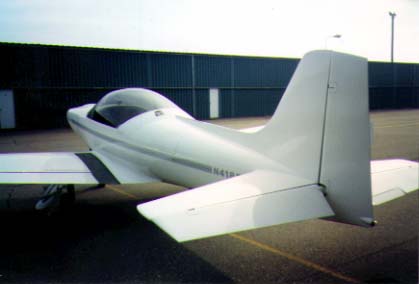First Flight:
Art Witzke
![]()
First Flight:
|
|
by Alfred Scott
This article appeared in the June 1996 Falco Builders Letter. |
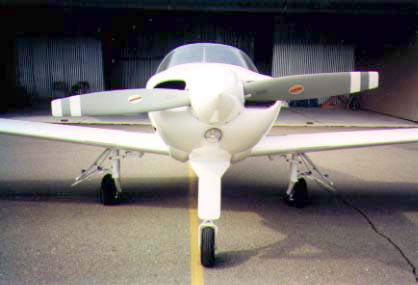
Italian corruption: Nustrini gear doors to go with the Nustrini canopy.
One problem with Richard Clements's scheme of painting your completion number-in his case, 50 for the 50th Sequoia Falco finished-is people like Art Witzke, whose Falco flew for the first time on December 8, 1994, and who just now has gotten around to telling anyone about it! Art may also have walked away with the longest completion time record at 13 years.
Art Witzke hails from Northville, Michigan. That's a Detroit suburb and, not surprisingly, he worked in the automotive field, as an engineering manager in engines at Ford Motor Company, handling the design and development of engines through all of the phases. He retired about 14 years ago, at a time when computers and electronics were just coming along. Art was strictly a slide-rule type, so he got out "just in time".
During WWII, Art started out as an engineering maintenance officer trained at Yale, and then when the B-29's came along, he transferred to the big bombers where he worked as a flight engineering instructor. That was the first plane that required a separate flight engineer to monitor and control the engines. In all, he put in about 800 hours in B-29s, training flight engineers over flights that would sometimes last 10-15 hours at 25,000 feet. It all required constant calculations for the power setting for various altitudes and weights, something that today would all be done by a microprocessor.
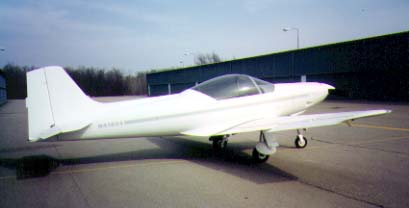
Art has always been a hobby-builder of things from an early age, and built model airplanes as a kid. So when he retired, he started right in on the Falco and worked at a leisurely pace. Art built all of the wood components but purchased most of the other kits.
The Falco has a 160 hp I0-320-B1A engine and constant-speed propeller, along with a Sky-Tec starter and Pelican alternator. Equipment includes an autopilot, Terra nav-com, loran and transponder. The Nustrini canopy is raised by 1 1/2" and Art installed a vertical extension of the diagonal frame No. 6 which seals against the canopy.
N41854 weighed in at 1,290 lbs empty, which is exactly the same as Dick Reichenbach's, which is based 100 miles north in Bay City.
When it came time for the first flight, Art enlisted the assistance of a friend who is into competition in a Yak. The initial flights were uneventful, and they've taken the Falco through all of its paces including some rather strenuous aerobatics including wingovers, aileron rolls, barrel rolls, hammerheads, spins, Immelmans, loops, Cuban eights, reverse Cuban eights, competition turns, and split-S's.
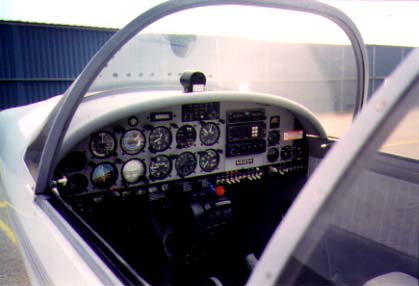
The Falco flew well from the beginning, and with a trim tab on the aileron and rudder to correct some very minor out-of-rig problems, the plane now flies hands off. Art says the handling is very nice. "I thought it would be lighter on the controls. I didn't find it that touchy." And aerobatics are "almost effortless."
The Falco now has about 50 hours on it, and Art has been getting more comfortable with the plane. He says his biggest problem is letting it down without overspeeding. "Things happen a bit too fast for me, so I get the gear down out of the pattern. To let down, I put the prop in max rpm and throttle back to 15 inches manifold pressure to use the prop as a brake."
When he was building the plane, for reasons that I've never understood, Art decided to build the wheel well doors in the same manner as he'd seen them in early photos of Luciano Nustrini's Falco. The doors were attached to the gear leg and there is a fairly complicated lever linkage required. This is the way the very first Falcos were built, and this method was abandoned in favor of the wheel well door design that we now use. In fact, Nustrini's Falco now uses this same design. The nose gear door is hinged on the engine mount and actuated by an arm that's attached to the nose gear trunnion.
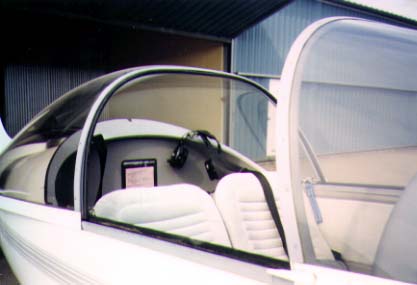
I never knew why the first method was abandoned, but maybe Art Witzke has re-discovered the reason. Mechanically, the landing gear doors work fine, and they produce a lot of drag when the gear is down. However, Art says "I can't say the wheel covers do anything for me. I did the initial flights without them, and surprisingly, I couldn't find that much difference in speed when I put them back on. Of course, I didn't do a calibrated run, so I don't have exact numbers."
The Falco cruises typically at 160-170 knots indicated at typical altitudes, which is "fast enough for me".
Art installed a Huntington lift reserve indicator, a rather rare device that he read about in The Aviation Consumer some years ago. This device is somewhat related to an airspeed indicator, but it measures differential air pressure from a probe that's installed under the right wing. You adjust it by changing the angle of the probe. I remember from reading the article that the inventor had a difficult time explaining the device in terms that others could understand, but it tells you how close you are to a stall. Art says the device works well in his Falco, and he's surprised at how little lift reserve you have immediately after takeoff.
One curious problem that Art reports is that the polyethylene Poly-Flo tubing in the pitot-static system has broken twice. In each case, it broke in the center of a large radius in the tubing leading to the pitot pressure switch. He said the tubing was cracked right in two, like a broken piece of glass. It makes no sense to him at all. The only explanation I can think of is that the length of tubing might have a harmonic frequency that sets up a vibration mode.
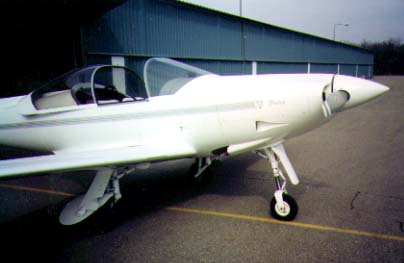
Other problems include a gear-down microswitch that was inoperative and problems with the Terra radios that have gone back to the factory 4 times. Most recently Art's biggest problem is a medical one, and he's currently waiting on getting his aviation medical back after some problems with blood pressure that came up when he went in for some oral surgery. Art says he's never had a problem before, but thinks perhaps the worry about the surgery brought it on. They gave him some medication for it, and this automatically voided his medical. So right now Art is waiting while doctors trade letters and clear things up.
The Falco is painted all white with gray striping. Art used an automotive paint, PPG acrylic urethane, because it holds up well and has a good finish, but he wasn't able to get a completely dust-free or bug-free painting environment. The nice thing about this paint is that you can sand and buff out any imperfections.
Art Witzke learned to fly about 30 years ago and over the years has owned a Cessna 150 and then a Beech Musketeer, which he sold when he got the Falco in the air. The Falco is based at the Howell, Michigan, airport. Stop by if you're in the area.
